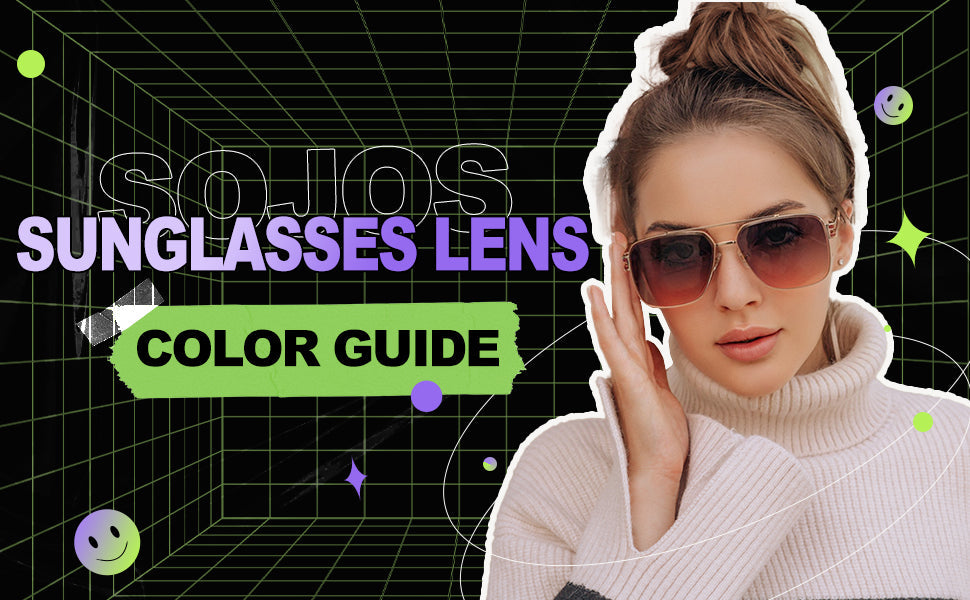
Sunglasses Lens Color Guide for the Coming Spring

Spring is right around the corner, and you know what that means! Warmer spring and summer days are on the way, so it's time to start thinking about sunglasses. Not only do they protect your eyes from the sun's harsh UV rays, but they come in a wide variety of lens colors to choose from - rose, smoke, blue, green - that can provide numerous benefits throughout spring and summer months.
For example, rose lenses can reduce glare while Smoke lenses make it easier to distinguish objects on bright days. Blue lenses provide protection against blue light - making them ideal for prolonged computer or device use – and green lenses help enhance the contrasts of any scene you're looking at outside. So pick up some new shades this spring season to give your eyes some extra protection and style!
Sunglasses are the perfect accessory for any outfit and can be an excellent way to express your personal style. But did you know that the color of your lenses can change more than just their look? In this sunglasses lens colour guide, we’ll explore the anatomy of a sunglass, different types of lenses, benefits of different lens colors and tips on how to pick the perfect pair!
Anatomy of a Sunglass
First let’s take a moment to understand the anatomy of a sunglass. Generally speaking, most sunglasses consist of two main parts- frames and lenses. Frames are typically made from metal or nylon which can provide strength and flexibility depending on what material you choose. The glasses lenses are usually made from either plastic or glass and come in many different styles and shapes. The shape and size of the lenses typically depend on the wearer’s face size.
Different Types of Sunglasses Lenses
1. Polarized Lenses
Polarized lenses are designed to reduce glare by blocking intense light reflection off horizontal surfaces like water or snow. Polarized sunglasses also help enhance contrast, making it easier to distinguish shapes in bright environments such as snow or water.
2. Photochromic Lenses
Photochromic lenses darken automatically in response to sunlight for better visibility in bright conditions. These lenses offer better clarity when driving because they reduce glare from headlights at night.
3. Mirror-Coated Lenses
Mirror-coated sunglasses have a reflective coating added to the outside surface that helps reduce brightness even further by reflecting incoming light away from your eyes so less light passes through them. This type of lens is an excellent choice for those who want maximum protection from harsh glares during intense outdoor activities such as skiing or biking.
Benefits of Different Lens Colors
Different colors react differently when exposed to sunlight, making each color best suited for certain activities or environments.
Yellow Lens
Yellow lenses are becoming increasingly popular due to the valuable benefits they can provide. The yellow tint helps sharpen details and improves contrast, allowing the user to have better vision in low-light conditions. This makes the yellow lenses ideal for activities such as skiing, water sports, and hunting. Additionally, yellow lenses enhance color perception, making them great for driving during the day or any other task that requires precision in differentiating colors. While yellow lenses are now perfect for all kinds of activities thanks to their enhanced color perception and enhanced detail for seeing in low-light situations, it's important not to wear yellow lenses if you're going out at night because they can dim your vision.
Green Lens
Wearing green lenses can be an incredibly beneficial choice for outdoor activities, as green lenses are adept at filtering out blue light coming from the sun. This helps to reduce glare and eye fatigue since green lenses help to absorb excess light and deflect it away from directly reaching and straining your eyes. Furthermore, having green lenses will allow you to easily discern between greens and blues with amazing clarity, making these lenses a great choice when fishing or golfing in bright sunlight where yellowish hues can dominate the landscape.
Purple Lens
Wearing purple-tinted lenses can provide many unique benefits. For athletes, purple lenses help to block out the blue light of digital screens, decreasing eye strain during long hours of intensive computer work and reducing the risk of headaches or blurred vision. Those who are in professions that require great visual accuracy, such as surgeons, may also opt for purple lenses for increased contrast and clarity when completing detailed tasks. Purple lenses can even help those with color blindness to distinguish better between images with very slight color differences. With so many potential uses, wearing purple-tinted lenses is an effective way to achieve improved vision and better sight acuity in a variety of scenarios.
Gray Lens
Wearing the correct lenses for any given situation is essential to seeing clearly and providing adequate protection for your eyes. Different colors of lenses offer different benefits; gray lenses, for example, are an excellent choice when performing activities in changing light conditions, as they provide true color representation and consistency of vision. Gray lenses reduce glare and eye fatigue by blocking out blue light while providing increased contrast. On bright sunny days, they provide maximum polarization while still allowing sufficient levels of light transmission – great news if you're a sports enthusiast looking to stay comfortable while participating in your favorite outdoor activity. All things considered, gray lenses are an excellent option to keep on hand!
Conclusion
Choosing the right colored sunglass lenses can make all the difference in how successful your outdoor activity session is! Be sure you make an informed decision about which type of lens will work best for you based on its advantages over other colors so that you get maximum protection from harmful UVA/UVB rays while also enjoying enhanced clarity in whichever environment you find yourself in!





